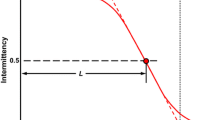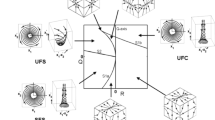Abstract
We show in this paper that a Hele-Shaw burner can be used for studying the development of premixed flame instabilities in a quasi-two dimensional configuration. It is possible to ignite a plane flame at the top of the cell, and to measure quantitatively the growth rates of the instability by image analysis. Experiments are performed with propane and methane-air mixtures. It is found that the most unstable wavelength, and the maximum linear growth rate of perturbations, directly measured in the present experiments, have the same order of magnitude as those previously measured on flames propagating freely downwards in wide tubes.


















Similar content being viewed by others
References
Clavin, P., Searby, G.: Combustion Waves and Fronts in Flows. Cambridge University Press, Cambridge (2016)
Kobayashi, H., Kawazoe, H.: Flame instability effects on the smallest wrinkling scale and burning velocity of high-pressure turbulent premixed flames. Proc. Combust. Inst. 28, 375–382 (2000)
Savarianandam, V.R., Lawn, C.J.: Burning velocity of premixed turbulent flames in the weakly wrinkled regime. Combust. Flame 146, 1–18 (2006)
Fogla, N., Creta, F., Matalon, M.: The turbulent flame speed for low-to-moderate turbulence intensities: hydrodynamic theory vs. experiments. Combust. Flame 175, 155–169 (2017)
Sivashinsky, G.I.: Nonlinear analysis of hydrodynamic instability in laminar flames I. Derivation of basic equations. Acta Astronaut. 4, 111 (1977)
Almarcha, C., Denet, B., Quinard, J.: Premixed flames propagating freely in tubes. Combust. Flame 162, 1225–1233 (2015)
Gostintsev, Y.A., Fortov, V.E., Shatskikh, Y.V.: Self-similar propagation law and fractal structure of the surface of a free expanding turbulent spherical flame. Dokl. Phys. Chem. 397, 141–144 (2004)
Quinard, J.: Limites de stabilité des structures cellulaires dans les flammes de prémélange, étude expérimentale. Thèse d’état, Marseille (1984)
Quinard, J., Searby, G., Denet, B., Graña-Otero, J.: Self-turbulent flame speeds. Flow Turbul. Combust. 89, 231–247 (2012)
Joulin, G., Sivashinsky, G.I.: Influence of momentum and heat losses on the large-scale stability of quasi-2D premixed flames. Combust. Sci. Technol. 98, 11–23 (1994)
Sharif, J., Abid, M., Ronney, P.D.: Premixed-gas flame propagation in Hele-Shaw cells. In: Spring Technical Meeting, Joint US Sections. http://ntrs.nasa.gov/archive/nasa/casi.ntrs.nasa.gov/20000005014.pdf. Combustion Institute, Washington, DC (1999)
Wongwiwat, J., Gross, J., Ronney, P.: Flame propagation in narrow channels at varying Lewis number. In: 25th ICDERS Leeds UK August 2–7 (2015)
Almarcha, C., Quinard, J., Denet, B., Al-Sarraf, E., Laugier, J.M., Villermaux, E.: Experimental two dimensional cellular flames. Phys. Fluids 27, 091110 (2015)
Clanet, C., Searby, G.: First experimental study of the Darrieus-Landau instability. Phys. Rev. Lett. 80, 3867–3870 (1998)
Truffaut, J.M., Searby, G.: Study of the Darrieus-Landau instability on an inverted-‘V’ flame, and measurement of the Markstein number. Combust. Sci. Technol. 149, 35–52 (1999)
Denet, B., Haldenwang, P.: A numerical study of premixed flames Darrieus-Landau instability. Combust. Sci. Technol. 104, 143–167 (1995)
Kang, S.H., Im, H.G., Baek, S.W.: A computational study of Saffman-Taylor instability in premixed flames. Combust. Theor. Model. 7, 343–363 (2003)
Kang, S.H., Baek, S.W., Im, H.G.: Effects of heat and momentum losses on the stability of premixed flames in a narrow channel. Combust. Theor. Model. 10(4), 659–681 (2006)
Pelcé, P., Clavin, P.: Influence of hydrodynamics and diffusion upon the stability limits of laminar premixed flames. J. Fluid Mech. 124, 219–237 (1982)
Clavin, P., Garcia, P.: The influence of the temperature dependence of diffusivities on the dynamics. J. Méc. Théor. Appl. 2(2), 245–263 (1983)
Matalon, M., Matkowsky, B.J.: Flames as gasdynamic discontinuities. J. Fluid Mech. 124, 239–259 (1982)
Frankel, M.L., Sivashinsky, G.I.: The effect of viscosity on hydrodynamic stability of a plane flame front. Combust. Sci. Technol. 29(3–6), 207–224 (1982)
Truffaut, J.M.: Etude expérimentale de l’origine du bruit émis par les flammes de chalumeaux. 1998. Thèse de doctorat. Université de Provence-Aix-Marseille I (1998)
Frankel, M.L., Sivashinsky, G.I.: On effects due to thermal expansion and Lewis number in spherical flame propagation. Combust. Sci. Technol. 31(3–4), 131–138 (1983)
Goodwin, D.G., Moffat, H.K., Speth, R.L.: Cantera: an object-oriented software toolkit for chemical kinetics, thermodynamics, and transport processes. https://doi.org/http://www.cantera.org, Version 2.3.0. https://doi.org/10.5281/zenodo.170284 (2017)
Chemical-Kinetic Mechanisms for Combustion Applications, San Diego Mechanism web page, Mechanical and Aerospace Engineering (Combustion Research), University of California at San Diego, http://combustion.ucsd.edu (2017)
Acknowledgements
We thank Guy Joulin for many stimulating discussions on the Hele-Shaw configuration.
Funding
This work was supported by the French National Research Agency (project PDF) under agreement ANR-14-CE05-0006. The project leading to this publication has received funding from Excellence Initiative of Aix-Marseille University - A*MIDEX, a French “Investissements d’Avenir” program. It has been carried out in the framework of the Labex MEC.
Author information
Authors and Affiliations
Corresponding author
Ethics declarations
Conflict of interest
The authors declare that they have no conflict of interest.
Additional information
Publisher’s Note
Springer Nature remains neutral with regard to jurisdictional claims in published maps and institutional affiliations.
Appendix: Gas Expansion
Appendix: Gas Expansion
We have shown in this article that the growth rates of the hydrodynamic instability in the Hele-Shaw cell, are generally smaller than those in a tube, which suggests that heat losses play a role. It would be interesting to measure the temperature profile in the burner, but this is a difficult task. We show in this section that by measuring the velocity field on both sides of the flame, burnt and fresh gasses, by a PIV technique using cesium oxide particles as seeding material, experimental values of the expansion ratio E can be obtained. It is known [24] that the normal mass flux is not exactly conserved across the flame, so measuring the velocity jump between fresh and burnt gasses does not give exactly the expansion ratio, however for our purpose we only need approximate values of the expansion ratio (these values will be used to discuss in more detail the Darrieus Landau instability in the Hele-Shaw burner in future papers). Figure 19 (propane ϕ = 0.9) shows the velocity field in the fresh and burnt gasses and the normals at different positions on the front in a small cell (60 cm × 1.5 cm × 5 mm). We use a smaller cell here in order to reduce the presence of cusps on the front, the heat losses however are slightly increased.
Figure 20 shows the normal velocity profile deduced from the previous figure at different positions on the front. Taking the average of velocity ratio between burnt and fresh gasses in the different curves of Fig. 20, we obtain a gas expansion E = 6.1 ± 0.25, which can be compared to the value obtained by Cantera [25] with a San Diego mechanism [26] E = 7.57 for propane at ϕ = 0.9. As expected the value obtained experimentally is slightly lower, probably because of heat losses. The typical thickness of the velocity profile is also close to the one given by complex chemistry, shown as a dashed line on the figure. Note that these profiles are obtained by PIV, it is possible that out-of-p] heat losses have an important role in the Hele-Shaw cell, which could be described by a lower gas expansion.
Rights and permissions
About this article
Cite this article
Sarraf, E.A., Almarcha, C., Quinard, J. et al. Quantitative Analysis of Flame Instabilities in a Hele-Shaw Burner. Flow Turbulence Combust 101, 851–868 (2018). https://doi.org/10.1007/s10494-018-9940-4
Received:
Accepted:
Published:
Issue Date:
DOI: https://doi.org/10.1007/s10494-018-9940-4






